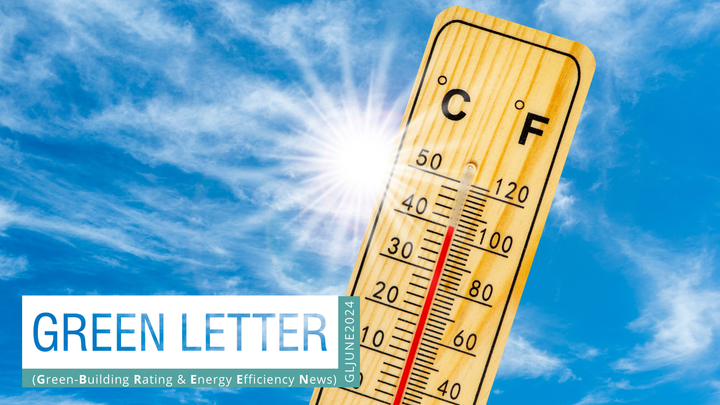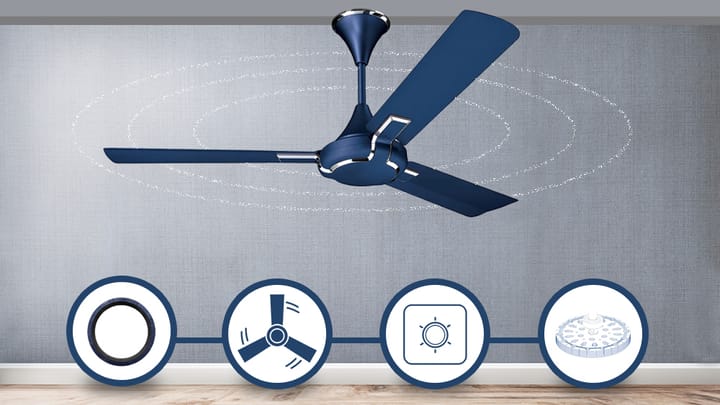A Narrative on Urban Heat Island (UHI) in India
a need for a system thinking approach to integrate technologies and policies for climate and humankind
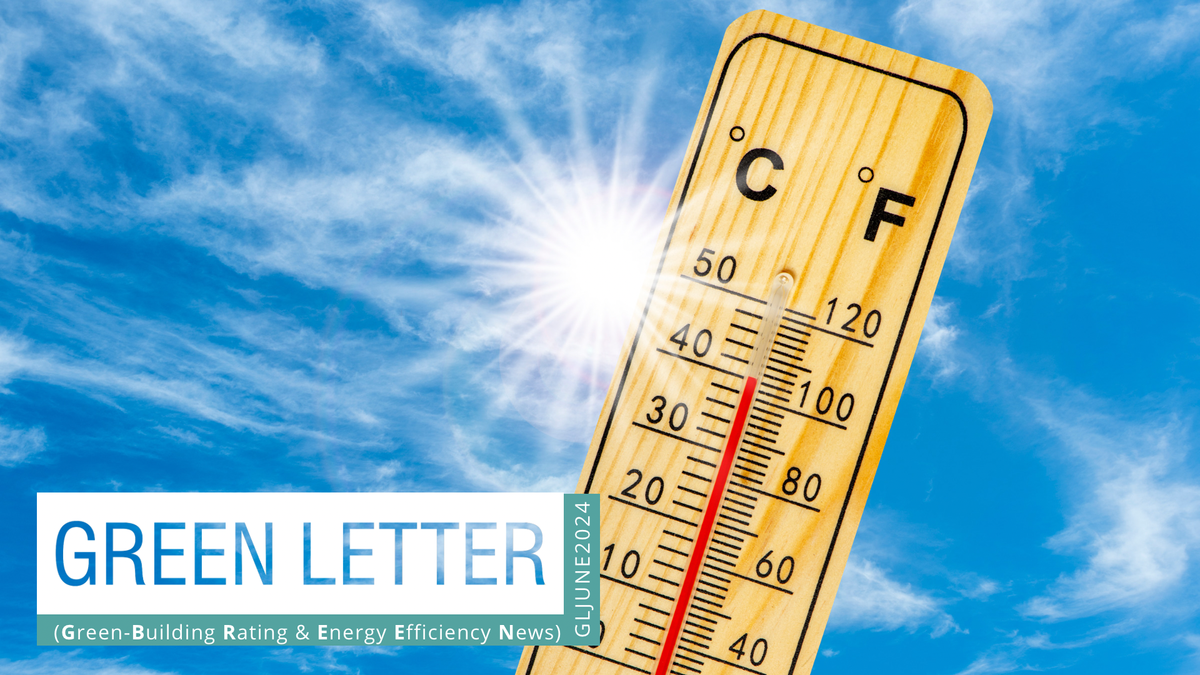
Introduction
The global temperatures are on the rise. Current data[1] show that global temperatures have been increasing by 0.360 C per decade since industrialization, and the warmest year on record is just a year ago[2]- 2023, with average temperatures 1.350 C above the pre-industrial average. It’s now a known fact that climate change is happening and its effects are being felt across the globe. The increasing frequency of extreme weather events, rising sea levels, and melting ice caps all point towards climate change. Humanity is responsible for exacerbating climate change and is the most impacted due to climate change. Scientists predict rising sea levels could displace 250-400 million[3] people in the next 80 years. Currently, the world’s urban areas are coastal, hosting around 37% of the world’s population at a population density twice the global average[4]. The predicted increase in urban population[5] to 68% by 2050 from the current 55% could only mean worse. Urbanization is shown to be one of the leading causes that alter urban climate and add to global GHG emissions. Studies[6] show that 70% of global CO2 emissions occur due to human anthropogenic activities within urban regions. Therefore, urban areas of the world are both at the creating and receiving end of this global climate change phenomenon, and one of the most dominant impacts of urbanization on climate is the Urban Heat Island (UHI) phenomenon.

Urban Heat Islands (UHI)
Factors contributing to UHI formation
Several natural and human-modified changes impact the urban climate across temporal and spatial scales. From small-scale turbulences at the micro-scale to macro-scale jet streams and hurricanes, the climatic system is altered by the natural and human-modified characteristics of the earth's surface. While natural impacts of the earth's surface on climate may or may not be interfered with, it is crucial to understand and limit the negative impact of the human-modified environment on climate. Urban areas are the best examples of human-modified environments. Human-made modifications of urban areas, such as their function, texture, and form. All of which could influence the urban climate and lead to the formation of Urban Heat Islands.

The Urban Heat Island (UHI) effect, characterized by higher temperatures in urban areas compared to their rural surroundings, is one of the most frequently observed urban climate modifications. The earliest UHI studies date back to the 1800s when Luke Howard noted that air temperatures in urban regions of London were higher than those in rural areas. Since then, UHI research has quantified the extent of the effect by measuring the temperature difference between urban and rural areas.

UHI types
Based on the location of the temperature measurement addressing different spatial scales, there are three different types of UHI: Surface UHI (SUHI), Canopy UHI (CUHI), and Boundary Layer UHI.
- SUHI represents the land surface temperatures (LST) commonly measured using remote sensing methods
- CUHI is quantified using air temperature measurements within the urban canopy (approximately 2 meters from ground level), and
- Boundary Layer UHI is also air temperatures measured in the urban boundary layer (an imaginary layer above urban areas)
While SUHI and CUHI are most relevant when referring to UHI's impact on human well-being and building energy consumption, boundary layer UHI reflects macro-scale weather changes happening across urban areas[8][9].
Some characteristics of urban areas that could lead to UHI formation are:
- Increased absorption of solar radiation through the built-up surfaces.
- Increased long-wave radiation that gets trapped between urban canopies.
- Increased sensible heat storage in built-up areas, encompassing all the impervious surfaces.
- Increased anthropogenic heat generation from humans, air conditioners, electrical equipment, and vehicular traffic.
- Reduction in latent heat fraction due to low pervious surfaces and vegetation.
- Reduction in wind speeds due to urban form.
All these heat exchanges occurring within the urban environment differ in magnitude compared to rural areas, where there is less development and more greenery, leading to lower temperatures than those found in urban areas.
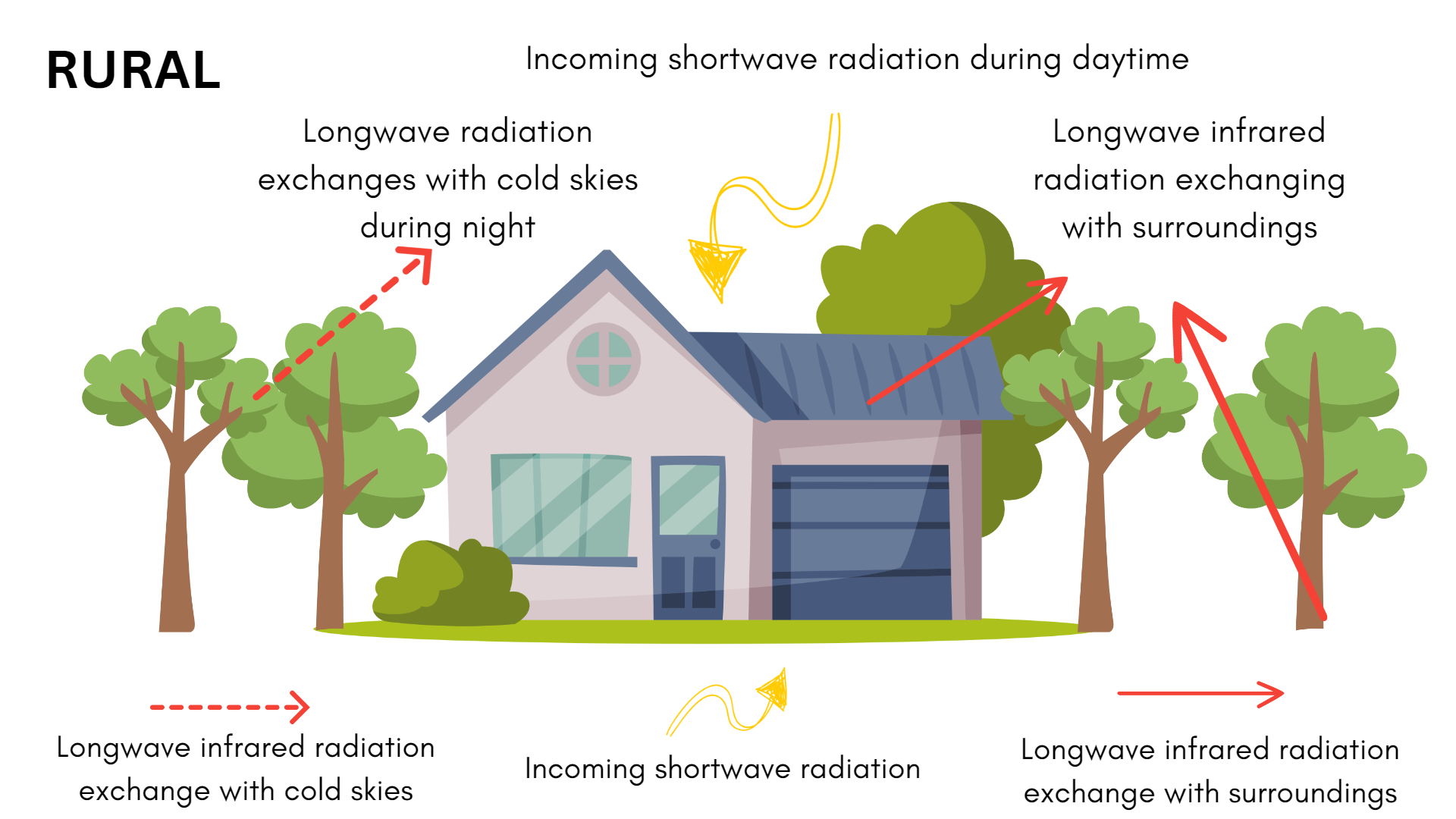
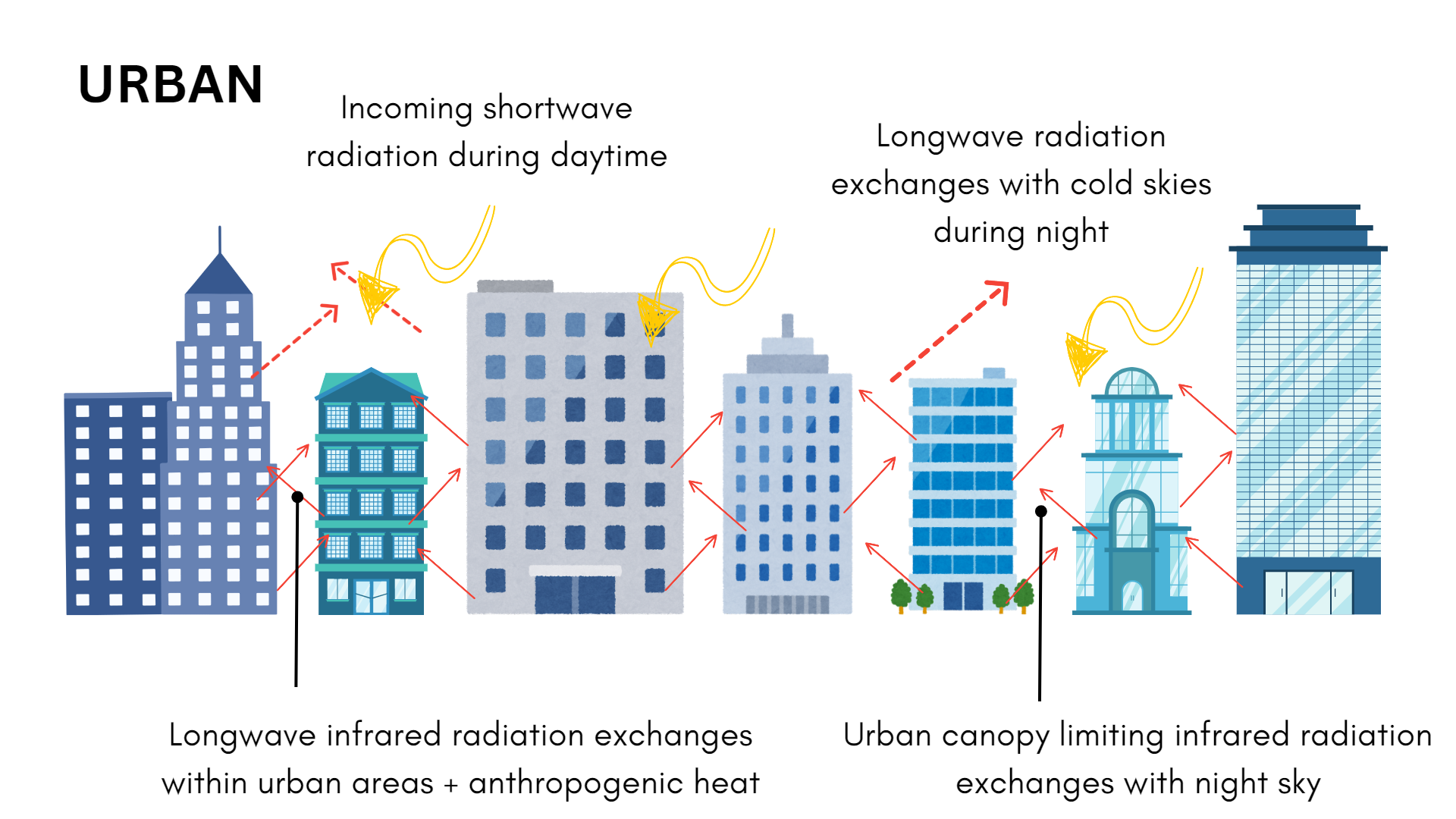
Figure 4: Differences in energy exchanges between urban and rural areas attributed to the UHI formation
Impacts of UHI
Irrespective of the type of UHI, this phenomenon is shown to impact urban climate, human well-being, energy consumption, and water availability. UHI increases cooling energy consumption by approximately 19% and it intensifies the heat stress, especially during the nighttime. The average nighttime SUHI intensity across 42 highly populated cities in India was 1.20C[10] which could impact human comfort and well-being. Studies show that even a small (less than 10C) rise in temperatures could power extreme weather events[11]. In addition, exposed surfaces in urban areas can be 30˚C to 40˚C hotter than the ambient air temperature during peak summers. As a result, the UHI phenomenon has numerous adverse effects. At a micro-scale, it increases building energy consumption and reduces occupant comfort. At the city level, it leads to elevated air temperatures, air pollution, and smog. Research also suggests that UHI can alter weather patterns and water quality, thereby impacting the environment, human health, and economic prosperity. Among its impacts on people, peak summer events can be fatal for vulnerable populations such as the elderly, urban workers, and the impoverished. Therefore, understanding UHI in the urban context of India is crucial. It not only helps in improving overall urban well-being and reducing energy consumption but could also improve the liveability and comfort of the homeless and economically disadvantaged populations in the country.
UHI in India
Urban Heat and UHI
Like global averages, temperatures in India are rising. As shown in Figure 5, the increase in temperatures over the last 20 years is evident, using Hyderabad as an example. NOAA (National Oceanic and Atmospheric Administration) dry bulb temperature data indicate that from 2000 to 2019, temperatures in Hyderabad have risen by at least 1.0°C during the post-monsoon season and up to 1.8°C in the summer. This upward trend continues, as evidenced by the numerous heat waves in 2024, with temperatures reaching between 44°C and 50°C across the country. According to a recent study[12], India could experience a temperature rise of 1.1-5.1°C by 2100.
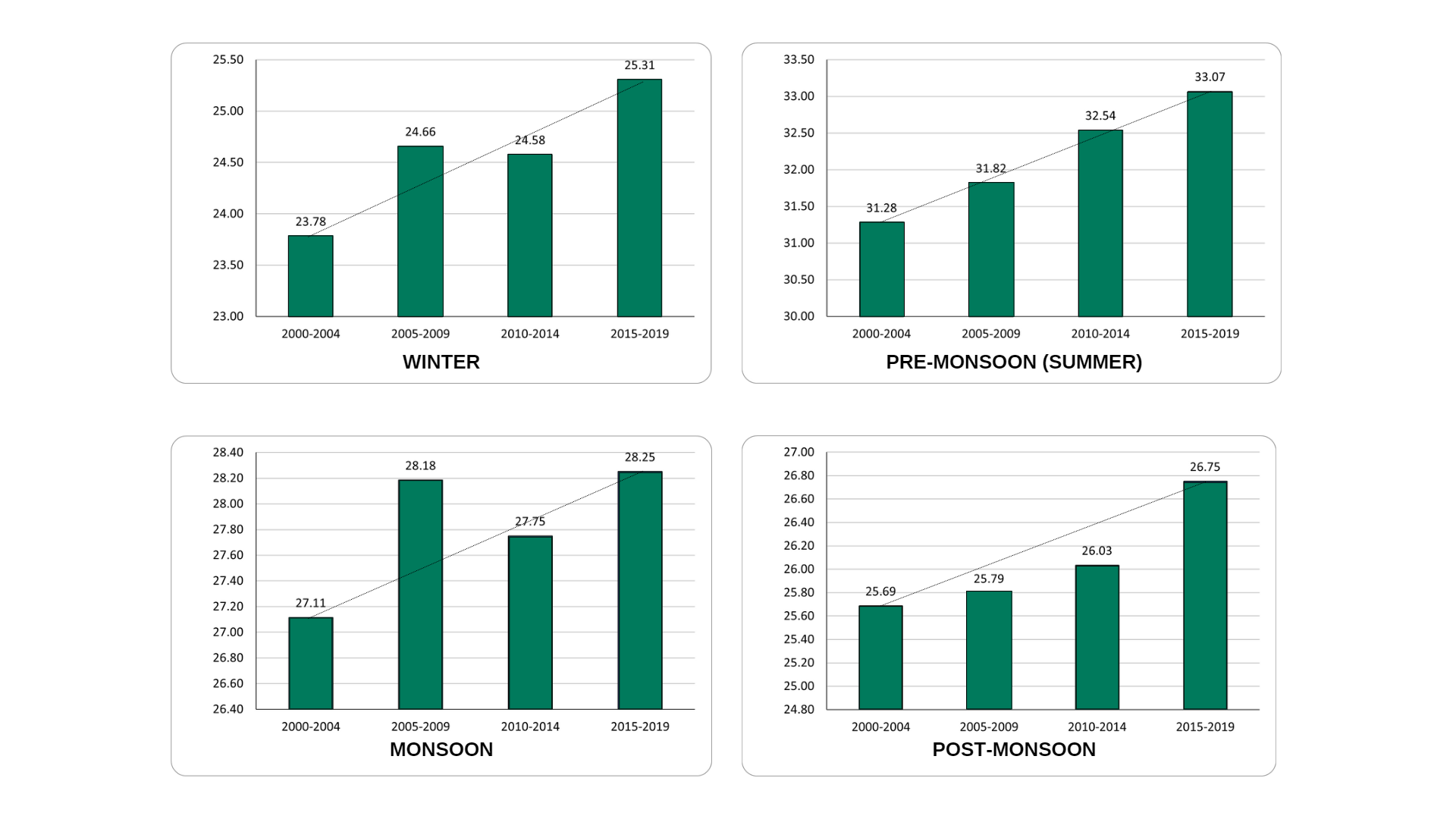
Additionally, land surface temperatures across 42 cities in India indicate that, although urban areas appear cooler than rural areas during daytime in the summer, this is not true for the rest of the seasons, particularly at night. During night time, the average UHI magnitude can reach up to 1.3°C, as seen in Figure 6. In another recent study[13], the authors showed that the average UHI magnitude in Bangalore and Hyderabad is 1.90C and 2.440C over the past two decades. All the existing research and data across cities in India show that UHI magnitude is increasing and is higher in the night time compared to the daytime. The already high temperatures and the high anthropogenic heat in the form of vehicles, humans, and building cooling, all add to a dense urban built environment that cannot cool off overnight, leading to an increased night time UHI magnitude.

Growing cities, hotspots, and heatsinks across Indian cities
As of 2023, while only 3.06% of land use in India is built-up areas, more than 40% of the Indian population lives in cities, and this is increasing[14]. By 2050, it is projected that around 60% of Indians are to live in urban areas. Today, urban areas of India contribute up to 44% of its GHG emissions[15]. The average increase in impervious surface area across 42 megacities in India is 68%, over 15 years from 2003 – 2018. Shown in Figure 7 is an example of Hyderabad, India which had a 58% increase in artificial (humanmade) impervious surfaces over 15 years.[10]

With cities expanding, the anthropogenic heat emissions of cities are also increasing. Expanding cities are also responsible for decreasing urban vegetation that could lead to UHI formation. In India, the quality and quantity of urban vegetation seem to impact the UHI formation.[16] A decrease in vegetation reduces the latent heat transfer impacting the micro-climate and reducing human comfort. The land surface temperature maps of different cities in India show that some of the hotspots within cities are densely built-up areas. Airport runways, dark roof industrial buildings, and other densely built-up areas are all prominent hotspots across all climate zones of India. On the other hand, urban parks and urban trees are the heatsinks. Further, in India, the vacant barren land parcels within urban regions could add to UHI formation. Densely built-up areas are on average 0.50C cooler compared to built-up areas with neighboring non-green vacant lands, and 1.30C warmer compared to built-up areas with neighboring vegetative land use.[10]

While urban land use and planning play a crucial role in the formation of UHI, the urban geometry and the urban building material properties are also important. Narrow urban canopies blocking the escape of the anthropogenic heat back into the cooler skies, increased population, and vehicular traffic on streets, also contribute to UHI formation.
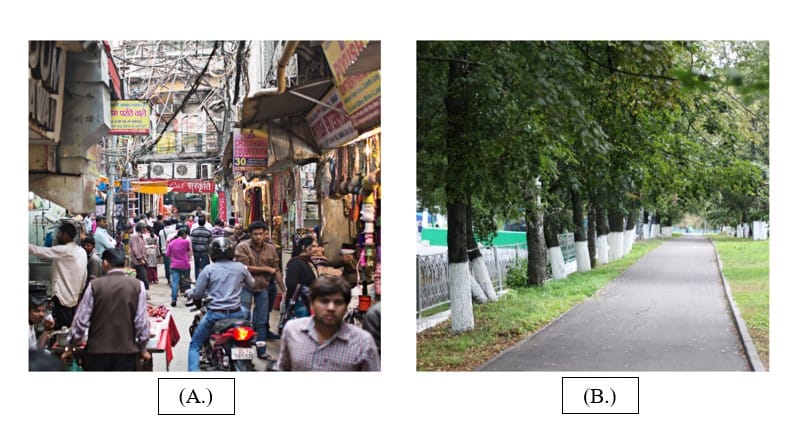
Urban Heat and Equity
India is home to the largest urban homeless population globally. While specific estimates vary across studies, the consensus remains clear: India faces a significant challenge with homelessness, urban street dwellers, and slum populations. This reality underscores the acute vulnerability of these communities to the Urban Heat Island (UHI) effect. A recent survey conducted in Delhi, India, revealed that the urban poor typically spend approximately 9.6 hours working outdoors, with 47% of respondents reporting suffering from heat-related losses and damages. Shockingly, none of those surveyed claimed to have adequate shelter capable of shielding them from extreme heat and weather conditions.
Independent research supports these findings, showing that most deaths occur during the summer months rather than in winter or the monsoon season. These statistics highlight the urgent need to address heat-related disparities and promote equity. In response, there is a pressing demand for inclusive strategies and policies designed for vulnerable populations to mitigate the adverse health effects of heat in urban communities.
One notable initiative is the establishment of cooling centers. Ahmedabad stands as a pioneering example, being the first city in India to implement a Heat Action Plan (HAP). Subsequently, several other cities have adopted similar plans. Under the Ahmedabad HAP, various public buildings such as temples, government structures, and shopping malls have been designated as cooling centers, offering temporary shelter to underprivileged urban residents during hot nights.
Similarly, HAPs implemented across different states emphasize the importance of cooling centers, heat health advisories, and enhancing public awareness. The UHI phenomenon exacerbates already elevated temperatures in Indian cities, significantly impacting urban populations, particularly those spending substantial time outdoors, thereby affecting overall health and well-being.
In conclusion, addressing the challenges posed by urban heat and its disproportionate impact on vulnerable populations is essential for ensuring the health and well-being of urban communities across India. Establishing cooling centers and implementing Heat Action Plans are crucial steps toward mitigating these risks. However, sustained efforts are necessary to expand and strengthen these initiatives.
UHI Mitigation Measures and Relevant Policies
The mitigation of Urban Heat Island (UHI) effects primarily revolves around two key categories: vegetation and urban built-up surface treatments.

The evapotranspiration process occurring during urban trees and vegetation is crucial in cooling the temperatures. In this process, the plants absorb water through the roots that eventually get evaporated through the leaves, adding moisture into the atmosphere and reducing the temperatures. In a city like Bangalore, the air temperatures in streets with trees can be up to 5.60C lower compared to the streets not shaded by trees[17]. Further, green roofs and green walls are proven to improve the comfort and well-being of the urban population by reducing temperatures. Vegetation not only reduces temperatures but is also shown to improve air quality. Urban agriculture is another solution to urban cooling and a solution that could implemented without depending on regional policies. With the increase in high rises, individual home gardens are shrinking. Scientists and policymakers should work towards bringing in the technologies and incentives that encourage citizens to grow plants at both individual capacity and community scale. Examples of such initiatives are the Community in Bloom initiative and the Skyrise Greenery incentive scheme of Singapore. The ‘Community in Bloom’ is a national gardening movement that promotes community gardening and active citizen participation in greening efforts. It encourages residents to cultivate gardens, plant trees, and beautify public spaces, fostering a sense of ownership and stewardship towards the environment. The ‘Skyrise Greenery Incentive Scheme’ encourages building owners to incorporate green roofs and vertical greenery systems into their properties. It provides funding support and incentives to promote the adoption of greenery on building surfaces, contributing to urban biodiversity and thermal comfort.
In terms of urban vegetation, Singapore stands out as a best-case scenario. Further, since India and Singapore are both tropical countries, learning from each other’s knowledge and experiences could be beneficial. Added to the need for urban vegetation incentives, schemes, policies, and awareness activities, creating an inventory and maps of existing trees within urban regions could serve as a baseline for identifying the areas with the lowest vegetation and exploring how vegetation could be improved. Identifying local tree species with wide canopies to provide shade, and require minimal irrigation would be key for countries like India. Urban greening policies in India should also consider the existing water scarcity and air pollution impacts on maintaining urban greenery. To overcome such challenges, UHI mitigation measures need to be diverse and cannot be just focused on urban greening activities.

According to the Cool Roof Rating Council, a cool roof reflects and emits the sun's heat back into the sky rather than transferring it into the building. The coolness of the roof is determined by two properties: solar reflectance and thermal emittance. Both properties are measured on a scale from 0 to 1, with higher values indicating cooler roofs. For conventional grey roofs, the solar reflectance value is typically around 0.3, whereas for a cool roof, it's about 0.7. Previous research indicates that conventional grey roofs can be 31-47°C hotter than the surrounding air temperature, while cool roofs tend to remain between 6-11°C warmer than the air temperature. In unconditioned spaces, cool roofs have been shown to enhance comfort, while in conditioned spaces, they reduce cooling energy consumption by 5%, thereby decreasing heat absorption into the immediate micro-climate and lessening the need for energy production, which in turn affects the macro-climate.

The advantages of cool roofs extend beyond merely reducing cooling energy consumption or enhancing thermal comfort. They have global implications for decreasing greenhouse gas (GHG) emissions and air pollution, thus helping to mitigate Urban Heat Island (UHI) formation in various ways. While cool roof technology is well-established with numerous options available in the market, costs remain higher compared to conventional roofs. However, the payback period for cool roofs is typically within five years at most. Although the use of cool roofs is more common in green buildings, a pioneering statewide policy on cool roofs was only introduced in 2023 in Telangana, a state where 47% of the population resides in urban areas. While such policies should be more widespread, it is crucial to ensure their adaptation and effective implementation. Working toward the appropriate implementation of such policies is essential for mitigating the UHI phenomenon.

Adding to the cool roof programs will be the cool pavement initiatives that promote the use of high solar reflectance material and/or green pavements across the sidewalk and impervious areas of the city. An example of such board policies including multiple surfaces from the city is the ‘Cooling Singapore’ initiative. Improving the permeability of surfaces and reducing the non-impervious surfaces in urban areas could make a difference in reducing overall temperatures in urban regions, and hence mitigating the UHI effect. Cool coatings on conventional asphalt, permeable asphalt, permeable concrete, grass pavers, brick pavers, etc. are all examples of cool pavements. Just like all the other mitigation measures, the magnitude of the impact of such technologies and measures could be location-specific, they are overall shown to mitigate the UHI effect by reducing air temperatures and improving air quality. Cool pavements are also great for reducing storm water run-off and therefore in addressing issues such as water quality and availability. Chicago’s Green Alley program is one such initiative that promotes cool pavements.

A green roof is a vegetative layer on the rooftop, that could either be intensive or extensive in style. Intensive green roofs have deep soil layers that could go beyond 15” deep while extensive ones are around 6” deep. Based on the building type, location, and use of the roof, either intensive, extensive, or semi-extensive roofs are to be chosen. Irrespective of the type all green roofs are shown to reduce surrounding air temperatures, improve comfort, and reduce the cooling energy consumption within the building on which the green roof has been installed. Added to these benefits is the reduction in stormwater runoff and an improvement in the overall quality of life of the occupants of the building. Currently, in India, there aren’t any specific policies focusing towards green roofs. The ‘Greening Enhancement’ initiative of Singapore encourages the planting of trees, the creation of parks and gardens, and the implementation of green roofs and walls on buildings and stands as an example of the policy measures that could increase the adoption of green roofs across cities and communities. While cool roofs and green roofs at the building level or community level are both encouraged and credited through rating systems such as the Indian Green Building Council (IGBC), till date, there aren’t any state-wide or national-level green roof policies in place for India.
Other UHI mitigation measures
In addition to these conventional UHI mitigation measures, there are a few other built-environment measures that could help in mitigating UHI. These include:
- Enhanced land use planning : Strategic land use planning can optimize green spaces, minimize impervious surfaces, and promote mixed land-use patterns, thereby reducing heat absorption and enhancing natural cooling processes.
- Energy-efficient and high-performance buildings : Incorporating energy-efficient design features – not limited to roof surface treatments, can help lower indoor temperatures and decrease the overall heat contribution from buildings to the urban environment.
- Systems integration across the built environment : Implementing integrated systems for energy, water, and waste management can foster synergies that minimize heat emissions and maximize resource efficiency, contributing to UHI mitigation efforts on a broader scale.
By incorporating these additional measures alongside traditional vegetation and surface treatments, cities can adopt a multifaceted approach to UHI mitigation, promoting resilience and sustainability in urban environments.
Current Challenges and Future Opportunities
Need for a holistic and integrated approach in designing buildings and urban spaces
While the aforementioned UHI mitigation measures have been demonstrated to directly reduce temperatures and thus mitigate UHI formation, the overall enhancement of urban areas and building design and planning also plays a crucial role in UHI mitigation. On the latter front, one significant impact of UHI on buildings is the increase in cooling energy consumption – a topic that has been extensively studied by building scientists. However, this represents just one facet of the equation. It is equally essential to understand how buildings and the built environment as a whole contribute to UHI. Research in this domain is still nascent, primarily due to the limitations in analysis tools and methodologies. Traditionally, while building and urban designers focused on enhancing the indoor performance and functionality of spaces, urban climatologists and meteorologists delved into atmospheric phenomenon like UHI, with minimal interaction between these two groups.
Moreover, UHI studies have typically been conducted on larger spatial scales such as local, meso, and macro scales, rather than the micro-scale where the impact on and by the buildings could be most significant. Nevertheless, this paradigm is evolving. Now, two centuries after Howard’s pioneering research on UHI London, with more than half of the world’s population residing in urban areas, and the then warmest years on record occurring with the past decade (2014-2023), understanding UHI dynamics and mitigating its effects has become imperative even for building scientist.
Gaining insights into the factors within the built environment and their magnitude of impact on UHI, particularly at varying spatial scales, could mark a significant stride toward leveraging buildings as tools for UHI mitigation. Similar to the evaluation of buildings' indoor and energy performance, assessing their outdoor thermal performance is essential to create 'micro-climate neutral' or 'zero UHI impact' buildings and communities. Integrating urban micro-climatic models with whole-building simulations should become the new standard.
One approach to achieving this is adopting a systems integration approach to whole-building performance. For instance, while vegetation aids in temperature reduction, urban greenery remains sparse in India. Given the potential water stress associated with maintaining urban greenery in India, enhancing and preserving greenery at the individual building or urban community level through systems integration might be more feasible. Implementing measures like reusing greywater and collecting rainwater for irrigation are examples of utilizing site water resources efficiently.
Therefore, systems thinking approach is needed to establish a built environment as a potential UHI mitigation measure, and this needs a wealth of knowledge from several disciplines.
Awareness and Outreach Activities
Enhancing research to identify localized mitigation measures is crucial, but alongside, raising awareness is paramount for improving urban environments. It is vital to establish public awareness and community outreach programs and involve citizen scientists in mitigating UHI. Such involvement of communities can significantly influence the success of policy development and implementation. Some of the suggested awareness and outreach activities in the field of UHI could be:
- Academic institutions should take the lead in organizing workshops and seminars across communities to disseminate knowledge about UHI and its mitigation strategies.
- Conduct educational campaigns and research activities in collaboration with local communities, governmental and non-governmental organizations working toward the same cause.
- Implement UHI mitigation demonstration projects within communities and involve residents in research activities related to UHI, fostering a sense of ownership and empowerment.
- Governments and NGOs involved in disaster preparedness and management should develop plans to enhance awareness of heat hazards, particularly in hotspots and during heatwave events.
- Develop media platforms and interactive tools accessible to the public to identify hotspots, cooling centers, urban parks, and receive notifications about heat-related events empowering individuals to take proactive measures to mitigate UHI effects.
Addressing Urban Heat for Urban Poor – An India-specific problem and possible solutions
As urban India embraces air-conditioned buildings, the adverse impact of such structures on outdoor temperatures exacerbates, disproportionately affecting vulnerable urban dwellers. Construction workers, the urban poor, pedestrians, and users of non-air-conditioned public transportation systems collectively constitute a significant portion of the urban population in India, and they bear the brunt of rising temperatures. To tackle these challenges, UHI mitigation strategies must be multifaceted:
- Increase Data and Research on Urban Poor and Urban Heat: Conduct studies similar to the one conducted for Delhi[19] across major cities in India to map temperatures and areas with high homeless populations. This information can help identify suitable locations for establishing cooling centers, enhancing the effectiveness of such initiatives.

- Establish Cooling Centers: Convert existing buildings or set up separate structures as cooling centers and shelters equipped with fans and air conditioning during heatwave events. These shelters should be strategically located in areas with high concentrations of homeless populations.
- Improve Urban Tree Cover: Develop maps highlighting the city's tree canopy and vacant spaces. Use this data to implement initiatives aimed at enhancing urban tree cover and establishing urban parks in hotspots. Community-led greening initiatives can complement these efforts.
- Enhance access to drinking water: Enhance access to drinking water for urban dwellers by installing public water sources and promoting community-based water distribution. Urban planning and design should integrate water features in urban parks and other areas to improve the micro-climate and facilitate cooling for urban populations.
- Policy development and implementation: Ensure that UHI-related policies specifically address the needs of vulnerable populations. Mitigation measures and implementation plans should prioritize improving the health and well-being of the urban poor, who are disproportionately affected by urban heat.
By implementing these multifaceted strategies, such as increasing vegetation, reducing impervious surfaces, and promoting sustainable building and urban design practices, India can effectively mitigate the impacts of Urban Heat Islands. An integrated approach not only helps in cooling urban areas but could contribute to a resilient and inclusive urban environment focused towards the well-being of all its residents, particularly the vulnerable populations. Systems integration and a bottom-up approach could therefore be key for cities in India to mitigate UHI and foster a healthier environment amidst the urban growth and climate challenges.
Green Building Market in India
The Green Buildings Market in India is registering positive growth with every passing quarter. We have conducted an in-depth market progress study on the growth potential of green buildings in India. Compared to the past quarter (October 2023 to December 2023), the quarter (January 2024 to March 2024) has registered a growth in green building registrations with each agency clearly indicating a bolstering economic recovery and a positive development of green footprint across the country.
For integrative analysis, the data for green building ratings project received from GBCI LEED and GRIHA, has been separately represented in the following sections.
GBCI LEED
The green building projects have demonstrated exceptional commitment to sustainability over the past quarter, as evidenced by their GBCI LEED certification ratings. The distribution of these certifications includes 63% Gold, 36% Platinum, and 1% Silver (Source: Public LEED Directory). This highlights the dedication to achieving high standards in energy efficiency and environmental performance, with the majority of projects earning Gold and a significant portion reaching Platinum status.

GRIHA
GRIHA certification ratings have demonstrated its projects with the distribution of ratings as: 5 stars (7%), 4 stars (60%), 3 stars (27%), and 2 stars (6%) in Quarter 4: 2023-2024 (Source: GRIHA). As is evident with GRIHA-rated government projects, the State and Central projects are establishing great benchmarks of sustainability for a positive impact on the green buildings industry.

In-house Experts Comment
After the analysis of the challenges posed by Urban Heat Islands (UHI) and their implications for urban environments, UHIs are not merely an environmental issue but a critical public health and economic concern too. The proactive measures, such as the adoption of cool roofing materials, the creation of green spaces, and the implementation of urban planning policies that prioritize sustainability, are essential in mitigating UHI effects. The insights provided in this newsletter aim to equip policymakers, urban planners, and the general public with actionable knowledge to combat the adverse effects of UHIs effectively.
REFERENCES
[1] National Oceanic and Atmospheric Administration (NOAA)
[2] National Oceanic and Atmospheric Administration (NOAA)
[3] The Intergovernmental Panel on Climate Change
[4] Coastal zone management, UNEP - UN Environment Programme
[5] United Nations, Department of Economic and Social Affairs
[6] Cities and Climate Change, UNEP - UN Environment Programme
[7] C40 Cities Climate Leadership Group
[8] A comparative analysis of surface and canopy layer urban heat island at the micro level using a data-driven approach,
[9] Urban Heat Island studies: current status in India and a comparison with the international studies
[10] Surface Urban Heat Island: A Comparative Study Between India and the United States
[11] National Oceanic and Atmospheric Administration (NOAA)
[12] Enhanced surface temperature over India during 1980–2020 and future projections: causal links of the drivers and trends
[13] Geospatial and statistical analysis of urban heat islands and thermally vulnerable zones in Bangalore and Hyderabad cities in India
[14] Land Use Statistics – At a Glance | Official website of Directorate of Economics and Statistics, Department of Agriculture and Farmers Welfare, Ministry of Agriculture and Farmers Welfare, Government of India
[15] Assessment Framework | Climate Centre for Cities
[16] A multicity analysis of daytime Surface Urban Heat Islands in India and the US.
[17] Lionel Sujay Vailshery, Madhumitha Jaganmohan, Harini Nagendra. Effect of street trees on microclimate and air pollution in a tropical city.
[18] Assessment of cool roof technology for its energy performance in buildings
[19] Climate Change and the Urban Poor pdf
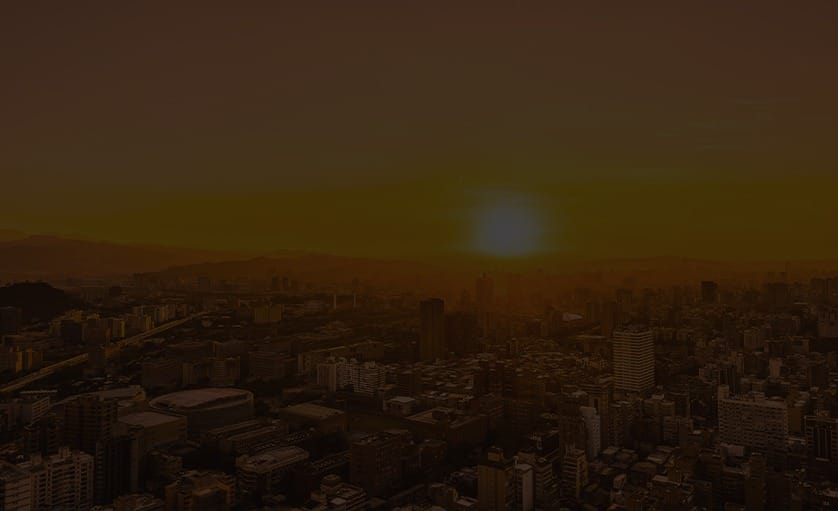
View the Interview with Dr. Surekha Tetali on Urban Heat Islands in India
Watch the Full InterviewGreenLetter (GLJune24) Writers: Dr. Surekha Tetali, Navneet Sharma, Shivani Rani, Anurag Bajpai
Follow our activities on Twitter | Linkedin | Youtube | Instagram | Facebook


